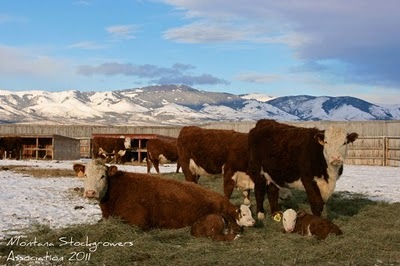The Case for Relative Forage Quality When Feeding Cattle Hay
 By Emily Glunk, MSU Extension Forage Specialist
By Emily Glunk, MSU Extension Forage Specialist
Feeding represents a large portion of the production and maintenance cost of animals. Some estimate that feeding can represent over 70% of the annual costs of maintaining a livestock herd, with hay representing a significant portion of that cost. Making sure that we are buying quality feedstuffs, and feeding in appropriate amounts, is critical in ensuring that we are being as economical as possible. In recent years, the cost of hay has increased significantly, and so efficient purchasing is critical.
A hay analysis is key in knowing the quality of the hay, how much to feed our animals, as well as being helpful in the buying process. Tools such as Relative Feed Value (RFV), which can be found on a hay analysis, have traditionally been used to compare hay. RFV uses fiber estimates, the acid detergent fiber (ADF) and neutral detergent fiber (NDF) portions of a hay analysis, to estimate the quality of the hay. This has been helpful in comparing between two types of similar hays, i.e. comparison of two alfalfa or two grass hays, however, it does not tell us everything about the availability of the fiber or other nutrients in that hay.
Several years ago, University of Wisconsin researchers developed a new method of comparison, called Relative Forage Quality, or RFQ. This value takes into account not only the fiber components of the plant, but the digestibility of those components as well. This tool is extremely helpful in telling us a little more about what may be available to the animal to use from that forage.
The ADF portion of a plant analysis is an estimate of the cellulose and lignin portion of the plants, cellulose being slowly fermented by the rumen or hindgut microbes before it can be converted into energy for the animal. Lignin is indigestible by both mammalian and microbial enzymes, and so is completely unavailable to the animal. Because it includes the parts of the plant that are relatively indigestible, ADF has been found to be negatively correlated to digestibility of plant material. This means that as ADF increases, digestibility of the plant decreases.
The NDF portion of a plant includes both cellulose and lignin, similar to ADF, but also includes hemicellulose, a fiber that is fermented more rapidly than cellulose by microbial enzymes in the hindgut or rumen. NDF has been found to be negatively correlated to intake, so as NDF increases, intake will decrease. This is largely a function of gut fill, so as an animal consumes a more fibrous feed, it will take less to fill up the gastrointestinal tract, thereby decreasing intake.
The problem with RFV is that it does not evaluate the availability of the nutrients. On average, a grass will typically have more fiber than a legume. However, the fibrous portion of grasses are usually more digestible than the fibrous portion of a legume. Relative forage quality, RFQ, was developed to help account for that, using total digestible nutrients (TDN) in the calculations. This will be a better indicator of what is available to the animals and the microbes within that animal to use, and convert to energy. RFQ is typically going to be higher in grasses than the RFV value, while legumes may slightly decrease.
RFQ and RFV are also a great means of evaluating who got a “better deal”. Typically, if the RFQ ends up being higher than the RFV, then we say that the buyer got a better deal. This is because initially, with RFV, we may have thought that the forage was more indigestible than it actually it, which was shown in the RFQ. If the RFQ is lower than the RFV, we like to say that the seller got the better deal, as the forage was higher in indigestible fiber, so less is going to be available to the animal to use.
It must always be kept in mind that both RFV and RFQ are to be used only as a comparison between hays, its purpose is not to aid in ration balancing, but as an evaluation and buying tool. For any questions, please contact Emily Glunk, MSU Extension Forage Specialist, at 406.994.5688 or [email protected].













